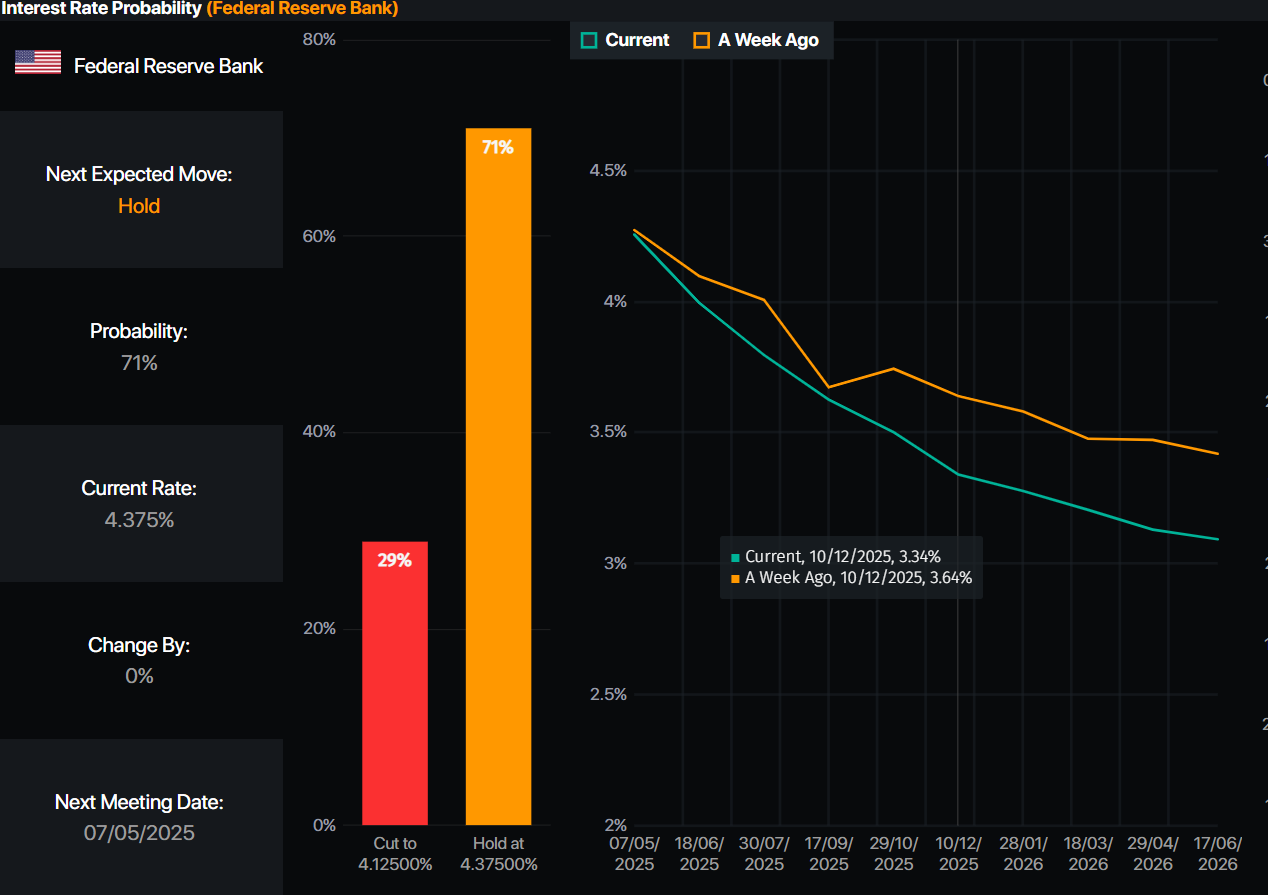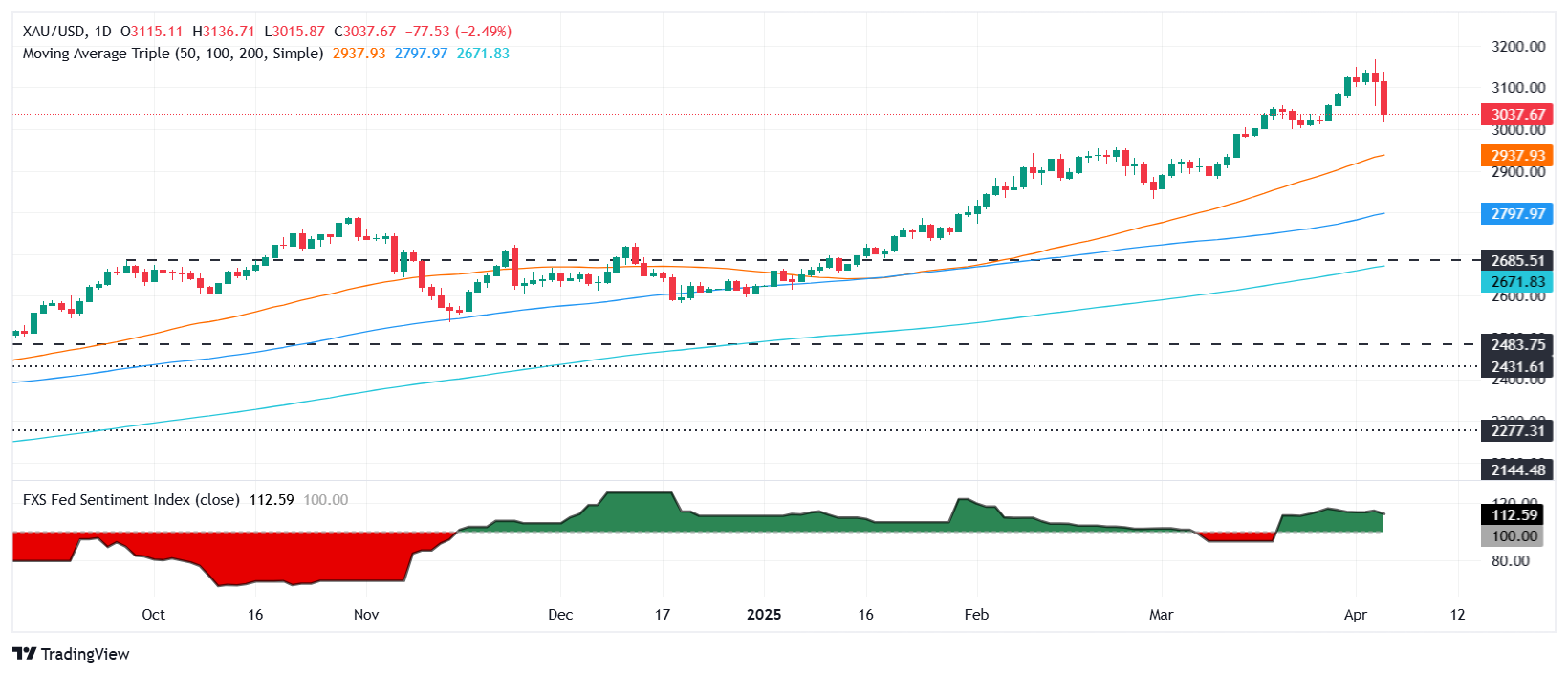Gold price slides as Powell warns on tariff-driven inflation
- XAU/USD is pressured by the Fed’s hawkish tone and a liquidity crunch.
- Powell signals tariffs could reaccelerate inflation, cooling rate cut bets and hammering Gold prices.
- Financial Times reports hedge funds face largest margin calls since Covid, sparking forced liquidation of assets.
Gold (XAU) price extended its losses on Friday and plunged to a seven-day low of $3,015 before recovering some ground, following a speech by Federal Reserve (Fed) Chair Jerome Powell, which indicated that inflation could reaccelerate due to tariffs. XAU/USD trades at $3,029, down 2.70%.
Financial markets turmoil continued amid the escalation of the trade war between the United States (US) and China. Alongside that, Powell poured cold water on Fed easing bets, commenting that tariffs are likely to have an impact on the US economy, including slower growth and higher inflation.
An article in the Financial Times (FT) revealed that hedge funds were hit by the most significant margin calls since Covid-19, following Trump’s Liberation Day.
Suki Cooper, an analyst at Standard Chartered, said, “We tend to see Gold as a liquid asset being used to meet margin calls elsewhere, so it's not unusual for Gold to sell off after a risk event given the role that it can play in a portfolio.”
Data-wise, the US economic docket featured a strong jobs report, highlighting that private companies hired over 200K people in March. The Unemployment Rate edged a tenth up, but Bloomberg stated that “it was mostly a rounding error.”
Money market traders had priced in over 1% of Fed easing by 2025, according to the data provided by Prime Market Terminal.

Source Prime Market Terminal
Recession fears ignited as depicted by the US10s to 3 months yield curve inversion, with the latter paying 25 bps more than the US 10-year yield.
Next week, the US economic docket will feature Fed speakers, the latest Federal Open Market Committee (FOMC) minutes, and the release of inflation data on both the consumer and producer side.
Daily digest market movers: Gold price tanks weighed by US Dollar strength
- The US 10-year T-note yield drops three basis points to 4.00%. US real yields edge down four bps to 1.718%, according to US 10-year Treasury Inflation-Protected Securities (TIPS) yields.
- The US Dollar Index (DXY), which tracks the performance of the buck against a basket of six currencies, rallies over 1.14% to 103.09, exerting pressure on Bullion prices.
- Fed’s Powell commented that monetary policy is appropriate as they wait for clarity before considering interest rate adjustments. He said, “Tariffs are likely to raise inflation in the coming quarters; more persistent effects are possible.”
- Powell added that the economic outlook is highly uncertain and that despite the economy being in a good place, downside risks have increased.
- March’s Nonfarm Payrolls exceeded forecasts of 135K and rose by 228K, significantly surpassing February’s 151K. The US Unemployment Rate edged up from 4.1% to 4.2%.
XAU/USD technical outlook: Gold price tumbles below $3,050
Gold is puking at the time of writing, as sellers continue to push prices lower, with them eyeing a challenge of the $3,000 mark. The Relative Strength Index (RSI), despite being bullish, is about to cross below its neutral level, which could be the latest sign that Gold is poised for a pullback.
If Gold prints a daily close below $3,000, the next support would be the 50-day Simple Moving Average (SMA) at $2,937, followed by the $2,900 figure. On the other hand, if XAU/USD edges up, buyers need to reclaim $3,100 to regain control.

Gold FAQs
Gold has played a key role in human’s history as it has been widely used as a store of value and medium of exchange. Currently, apart from its shine and usage for jewelry, the precious metal is widely seen as a safe-haven asset, meaning that it is considered a good investment during turbulent times. Gold is also widely seen as a hedge against inflation and against depreciating currencies as it doesn’t rely on any specific issuer or government.
Central banks are the biggest Gold holders. In their aim to support their currencies in turbulent times, central banks tend to diversify their reserves and buy Gold to improve the perceived strength of the economy and the currency. High Gold reserves can be a source of trust for a country’s solvency. Central banks added 1,136 tonnes of Gold worth around $70 billion to their reserves in 2022, according to data from the World Gold Council. This is the highest yearly purchase since records began. Central banks from emerging economies such as China, India and Turkey are quickly increasing their Gold reserves.
Gold has an inverse correlation with the US Dollar and US Treasuries, which are both major reserve and safe-haven assets. When the Dollar depreciates, Gold tends to rise, enabling investors and central banks to diversify their assets in turbulent times. Gold is also inversely correlated with risk assets. A rally in the stock market tends to weaken Gold price, while sell-offs in riskier markets tend to favor the precious metal.
The price can move due to a wide range of factors. Geopolitical instability or fears of a deep recession can quickly make Gold price escalate due to its safe-haven status. As a yield-less asset, Gold tends to rise with lower interest rates, while higher cost of money usually weighs down on the yellow metal. Still, most moves depend on how the US Dollar (USD) behaves as the asset is priced in dollars (XAU/USD). A strong Dollar tends to keep the price of Gold controlled, whereas a weaker Dollar is likely to push Gold prices up.


